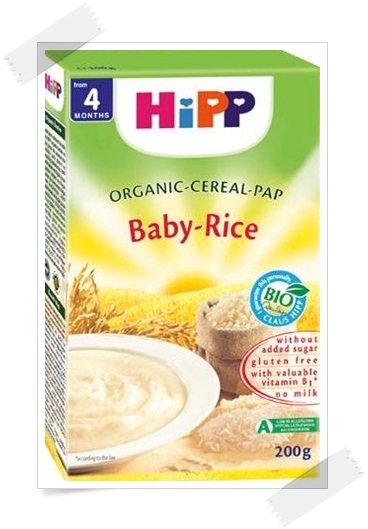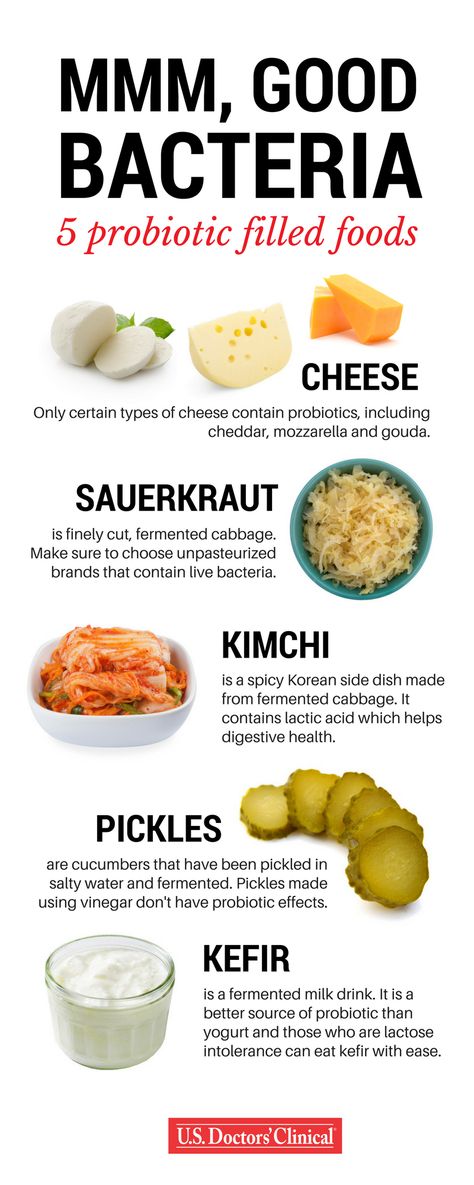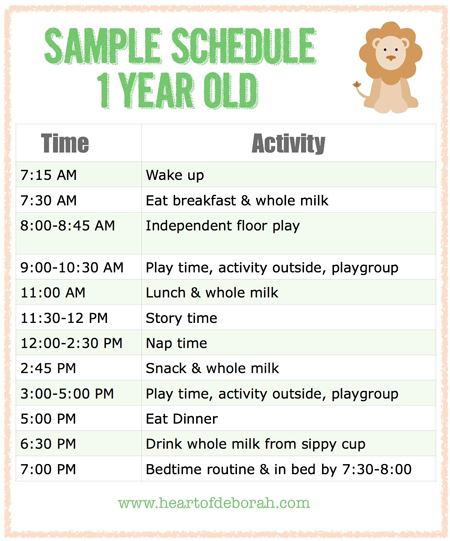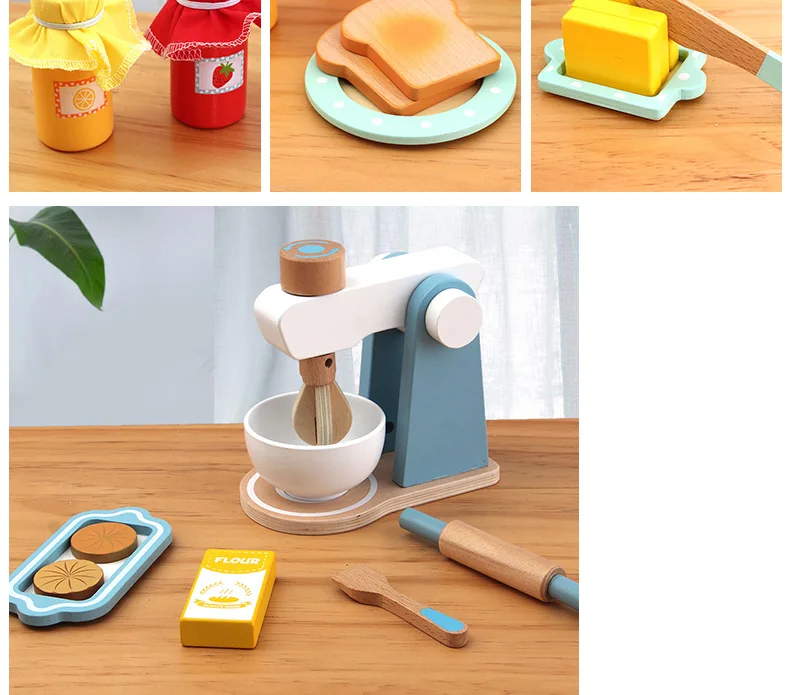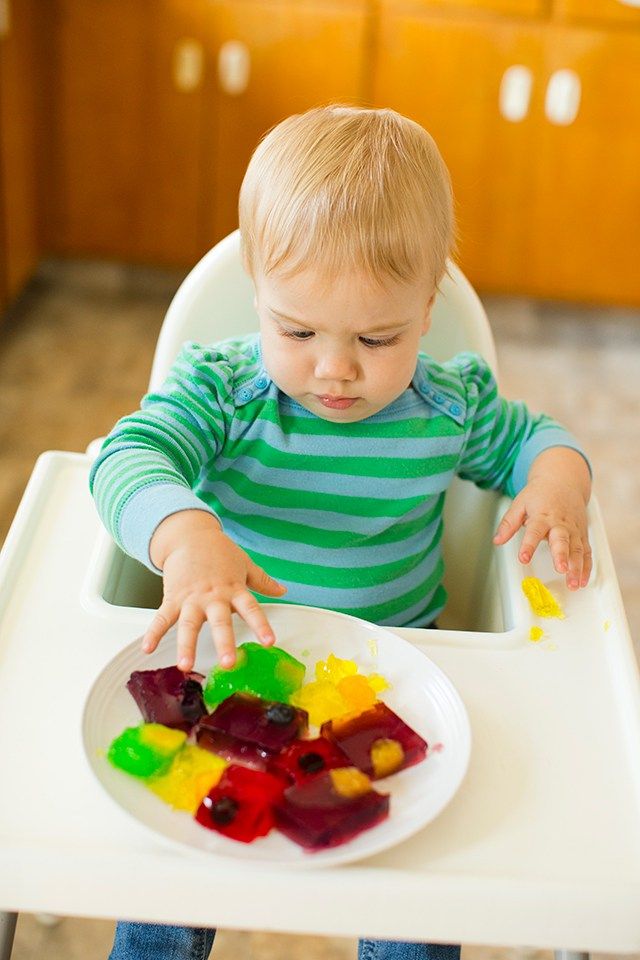Food chart for seven months old baby
An Authoritative Guide by Our Experts
Your little one is now 7 months of age. Should you change up his meal schedule? Or adjust the amount of food? Here’s what our experts have to say.
By Health Promotion Board in collaboration with A/Prof Mary Daniel Lourdes, Head & Senior Consultant, Clinical Services, Department of Child Development, KK Women's and Children's Hospital.
At 7 months old, your baby may already be on two solid meals a day. Fret not if he’s eating less solid food than that, as different babies progress at different speeds.
Recommended Number of Servings (7 months)
Here are the recommended number of servings per day for your baby's development. Remember, these numbers are only recommendations. Let your baby decide how much he wants to eat!
| Brown rice and wholemeal bread | Fruit | Vegetables | Meat and others | Milk (breast/formula) |
| 1-2 | ½ | ½ | ½ | 500-750ml |
7-month-baby Meal Schedule
Your meal schedule for the little one might look like this:
- Early morning snack: 150ml breast milk/formula
- Breakfast: 3 to 4 tablespoons of rice cereal mixed with 60ml breast milk/formula
- Mid-morning snack: 180ml breast milk/formula
- Lunch: ¼ to ¾ bowl* of solid food
- Afternoon snack: 180ml breast milk/formula
- Dinner: ¼ to ¾ bowl* of solid food
- Evening snack: 180ml breast milk/formula
*Rice bowl
Right now, your baby’s meals may typically be made up of a base wholegrain/grain (e. g. porridge) mixed with vegetable (e.g. pureed broccoli) and meat/others (e.g. tofu), perhaps with a tiny portion of fruit (e.g. apple and other fruit puree) when your baby feels up for it.
Broken down into these components, there are countless yummy meal combos you and your baby can explore. Just mix and match and let your creativity go wild! Read on for ideas on what you can feed your 7-month-old tot.
Related: Nutrition for Your Toddler
7-month-old Baby Food Ideas for Mummy and Daddy
Along the grain
You know brown rice cereal and brown rice porridge are good staples for your baby. But you’re ready to branch out. Why not try other iron-fortified cereals made from other wholegrains such as oat, barley, or millet? They are great sources of vitamins and minerals.
Related: No Wholegrain, No Gain
Variety of veggies
Pureed carrots, pumpkin, spinach… your baby might have already tried these typical “baby foods”. Expand the veggie menu: your baby might enjoy other vegetables such as butternut squash or brinjal, which can both be steamed until tender for effortless mashing. Broccoli and cauliflower are also mashable veggie options that are good sources of vitamin C.
Expand the veggie menu: your baby might enjoy other vegetables such as butternut squash or brinjal, which can both be steamed until tender for effortless mashing. Broccoli and cauliflower are also mashable veggie options that are good sources of vitamin C.
Related: Harness the Goodness of Fruit and Vegetables
Fruity fun
As for fruit, mummy and daddy can try venturing out of the sweet zone: your little one might enjoy the tart taste of fruit like cherries or plums (pits removed and pureed). So try feeding your little one some sour treats — and watch his face for when the flavour first hits him. Adorable! Note to mum and dad: no citrus fruit yet, though, as those are too acidic.
Baby not into sour fruit just yet? Why not try feeding him every millennial’s favourite fruit: the avocado! It’s easy to mash, and adds a subtle sweet flavor and creaminess to rice cereals.
Related: Fun Fruity Facts
Meet meat alternatives
Chicken and tofu are the safe baby food options, but your baby might be ready to handle other types of protein.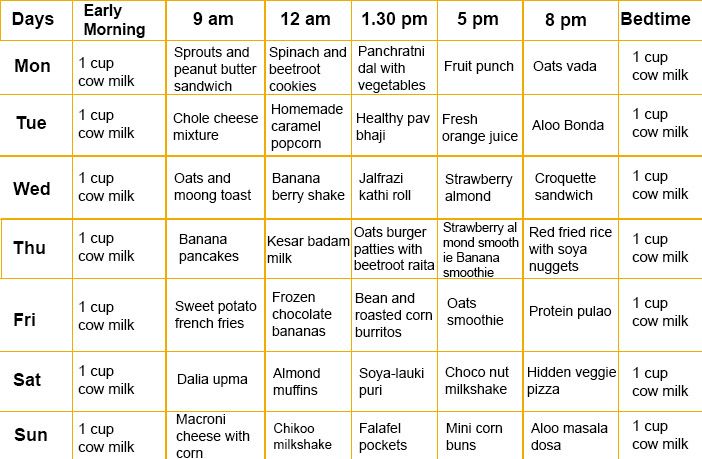 Looking for a protein-packed alternative to meat? Try pulses like mashed chickpeas or kidney beans.
Looking for a protein-packed alternative to meat? Try pulses like mashed chickpeas or kidney beans.
You can also introduce junior to fish such as salmon and cod—make sure you flake and mash them well. Do talk to your pediatrician before feeding fish to your baby if he has:
- Had an allergic reaction to food in the past
- A food allergy
- Chronic (long-term) eczema
Keep observing your child for signs of an allergic reaction after you feed him fish, as it is one of the most common food allergens. Signs include facial swelling, rashes, vomiting, diarrhea, and difficulty in breathing. Take your baby to the doctor if you spot any of these signs.
Related: Soya—The Unique Plant Protein
Try These Solid Meals!
Breakfast
- Oat cereal with breast/formula milk with pureed cherries
- Brown rice porridge with pumpkin puree
Lunch/Dinner
- Brown rice porridge with mashed chickpea and mashed cauliflower + tablespoonful of pureed plums
- Brown rice porridge with mashed butternut squash and mashed cod
- Millet cereal with apple and spinach puree, with pureed chicken
Related: Introducing Wholegrains to Your Child
Friendly Reminders for Mum and Dad
6 to 9 months: smooth, soft and fine texture
When you first start your baby on solids, the food you feed him should be smooth, soft, and fine in texture. As the little one grows older and gets better at chewing, you can gradually feed him food that is thicker and coarser—for example, a thicker puree.
As the little one grows older and gets better at chewing, you can gradually feed him food that is thicker and coarser—for example, a thicker puree.
Related: Your Growing Baby
Food prep pointers
If you’re making your own baby food, make sure to prepare it without oil. Some great cooking methods are steaming, boiling, baking, or microwaving. No stir-frying or grilling yet for the little one! Remember to skip the sugar, salt and any other seasonings (e.g. soy sauce) when preparing the meals.
Related: From Goreng to Grill: Healthier Cooking Methods
Be patient
If your baby isn’t interested in a certain food, do not force it. There’s also no need to force your child to finish everything on his plate! Stop feeding him if he rejects the food, and try again during the next meal. Right now, your baby knows best about how much he wants to eat.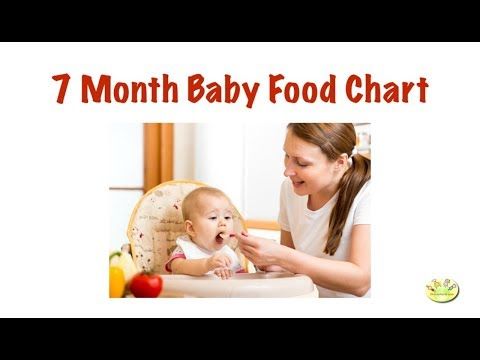
Related: Getting Ready for Solids
What makes 1 serving?
Brown rice and wholemeal bread | ½ bowl of brown rice/rice (100g) |
Fruit | 1 small apple, orange, pear or mango (130g) |
Vegetable | ¾ mug or 1 small rice bowl of cooked vegetables (100g) |
Meat and others | 1 palm-sized piece of fish, lean meat or skinless poultry (90g) |
This article was last reviewed on Tuesday, November 15, 2022
Programmes You May Like
View More Programmes
Stay Well to Stay Strong
Kickstart your healthy habits today with good hygiene practices, an active lifestyle, a balanced diet and sufficient sleep.
Programmes You May Like
View More Programmes
Catalog-Item Reuse
Your little one is now 7 months of age. Should you change up his meal schedule? Or adjust the amount of food? Here’s what our experts have to say.
<div><div><p>
By Health Promotion Board in collaboration with A/Prof Mary Daniel Lourdes, Head & Senior Consultant, Clinical Services, Department of Child Development, KK Women's and Children's Hospital. </p><p>At 7 months old, your baby may already be on two solid meals a day. Fret not if he’s eating less solid food than that, as different babies progress at different speeds.</p><h3>Recommended Number of Servings (7 months)</h3><p>Here are the recommended number of servings per day for your baby's development. Remember, these numbers are only recommendations. Let your baby decide how much he wants to eat!</p><div><table border="1" cellspacing="0" cellpadding="0"><tbody><tr><td>
</p><p>At 7 months old, your baby may already be on two solid meals a day. Fret not if he’s eating less solid food than that, as different babies progress at different speeds.</p><h3>Recommended Number of Servings (7 months)</h3><p>Here are the recommended number of servings per day for your baby's development. Remember, these numbers are only recommendations. Let your baby decide how much he wants to eat!</p><div><table border="1" cellspacing="0" cellpadding="0"><tbody><tr><td>
<strong>Brown rice and wholemeal bread</strong></td><td>
<strong>Fruit</strong></td><td>
<strong>Vegetables</strong></td><td>
<strong>Meat and others</strong></td><td>
<strong>Milk (breast/formula)</strong></td></tr><tr><td>1-2</td><td>½</td><td>½</td><td>½</td><td>500-750ml</td></tr></tbody></table></div><p>
</p><h3>7-month-baby Meal Schedule
</h3><p>Your meal schedule for the little one might look like this:
</p><ul><li>
<strong>Early morning snack:</strong> 150ml breast milk/formula
</li><li>
<strong>Breakfast:</strong> 3 to 4 tablespoons of rice cereal mixed with 60ml breast milk/formula</li><li>
<strong>Mid-morning snack:</strong> 180ml breast milk/formula</li><li>
<strong>Lunch:</strong> ¼ to ¾ bowl* of solid food</li><li>
<strong>Afternoon snack: </strong>180ml breast milk/formula</li><li>
<strong>Dinner: </strong>¼ to ¾ bowl* of solid food</li><li>
<strong>Evening snack:</strong> 180ml breast milk/formula</li>
*Rice bowl </ul><p></p><p>Right now, your baby’s meals may typically be made up of a base wholegrain/grain (e. g. porridge) mixed with vegetable (e.g. pureed broccoli) and meat/others (e.g. tofu), perhaps with a tiny portion of fruit (e.g. apple and other fruit puree) when your baby feels up for it.
g. porridge) mixed with vegetable (e.g. pureed broccoli) and meat/others (e.g. tofu), perhaps with a tiny portion of fruit (e.g. apple and other fruit puree) when your baby feels up for it.
</p><p>Broken down into these components, there are countless yummy meal combos you and your baby can explore. Just mix and match and let your creativity go wild! Read on for ideas on what you can feed your 7-month-old tot.</p><p>
<strong>Related:
<a href="https://www.healthhub.sg/live-healthy/1243/baby-nutrition-for-your-toddler" title="Nutrition for Your Toddler">Nutrition for Your Toddler</a></strong></p></div><div><h3>7-month-old Baby Food Ideas for Mummy and Daddy
</h3><p>
<img src="/sites/assets/Assets/Categories/Pregnancy%20and%20Infant%20Health/35_Opmz_621145626.jpg" alt="7-month baby diet includes pureed veggies " />
</p><h4>Along the grain</h4><p>You know brown rice cereal and brown rice porridge are good staples for your baby.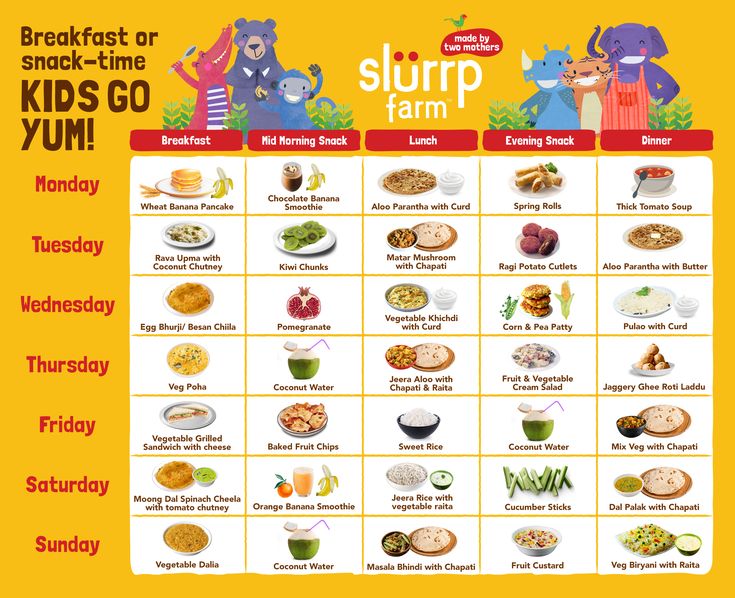 But you’re ready to branch out. Why not try other iron-fortified cereals made from other wholegrains such as oat, barley, or millet? They are great sources of vitamins and minerals.
But you’re ready to branch out. Why not try other iron-fortified cereals made from other wholegrains such as oat, barley, or millet? They are great sources of vitamins and minerals.
</p><p>
<strong>Related:
<a href="https://www.healthhub.sg/live-healthy/1831/no-wholegrain-no-gain" title="No Wholegrain, No Gain">No Wholegrain, No Gain</a></strong></p><h4>Variety of veggies</h4><p>Pureed carrots, pumpkin, spinach… your baby might have already tried these typical “baby foods”. Expand the veggie menu: your baby might enjoy other vegetables such as butternut squash or brinjal, which can both be steamed until tender for effortless mashing. Broccoli and cauliflower are also mashable veggie options that are good sources of vitamin C.</p><p>
<strong>Related:
<a href="https://www.healthhub.sg/live-healthy/514/Benefits%20of%20Fruit%20and%20Vegetables" title="Harness the Goodness of Fruit and Vegetables">Harness the Goodness of Fruit and Vegetables</a></strong></p><h4>Fruity fun</h4><p>As for fruit, mummy and daddy can try venturing out of the sweet zone: your little one might enjoy the tart taste of fruit like cherries or plums (pits removed and pureed).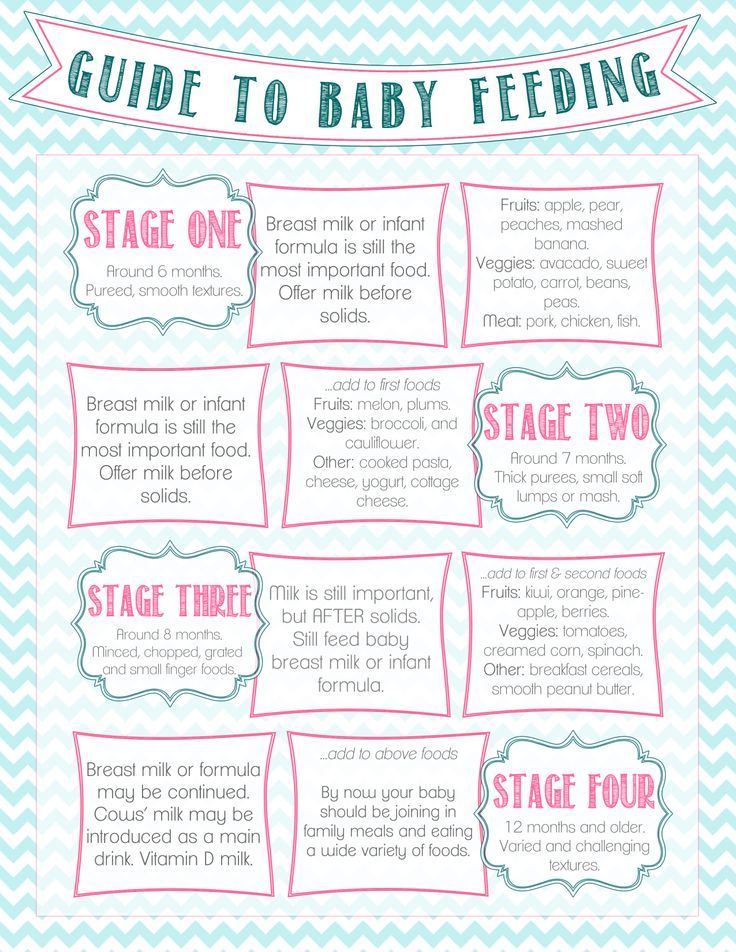 So try feeding your little one some sour treats — and watch his face for when the flavour first hits him. Adorable! Note to mum and dad: no citrus fruit yet, though, as those are too acidic.</p><p>Baby not into sour fruit just yet? Why not try feeding him every millennial’s favourite fruit: the avocado! It’s easy to mash, and adds a subtle sweet flavor and creaminess to rice cereals.</p><p>
So try feeding your little one some sour treats — and watch his face for when the flavour first hits him. Adorable! Note to mum and dad: no citrus fruit yet, though, as those are too acidic.</p><p>Baby not into sour fruit just yet? Why not try feeding him every millennial’s favourite fruit: the avocado! It’s easy to mash, and adds a subtle sweet flavor and creaminess to rice cereals.</p><p>
<strong>Related:
<a href="https://www.healthhub.sg/live-healthy/1291/fun-fruity-facts" title="Fun Fruity Facts">Fun Fruity Facts</a></strong></p><h4>
</h4><h4>
<img src="/sites/assets/Assets/Categories/Pregnancy%20and%20Infant%20Health/35_Opmz_597211418.jpg" alt="Avocado is easy to mash, sweet and creamy – perfect for 7-month-old babies" />
</h4><h4>
</h4><h4>Meet meat alternatives</h4><p>Chicken and tofu are the safe baby food options, but your baby might be ready to handle other types of protein. Looking for a protein-packed alternative to meat? Try pulses like mashed chickpeas or kidney beans.</p><p>You can also introduce junior to fish such as salmon and cod—make sure you flake and mash them well. Do talk to your pediatrician before feeding fish to your baby if he has:
Looking for a protein-packed alternative to meat? Try pulses like mashed chickpeas or kidney beans.</p><p>You can also introduce junior to fish such as salmon and cod—make sure you flake and mash them well. Do talk to your pediatrician before feeding fish to your baby if he has:
</p><ol><li>Had an allergic reaction to food in the past</li><li>A food allergy</li><li>Chronic (long-term) eczema</li></ol><p></p><p>Keep observing your child for signs of an allergic reaction after you feed him fish, as it is one of the most common food allergens. Signs include facial swelling, rashes, vomiting, diarrhea, and difficulty in breathing. Take your baby to the doctor if you spot any of these signs.</p><p>
<strong>Related:
<a href="https://www.healthhub.sg/live-healthy/190/soya_unique_plant_protein" title="Soya—The Unique Plant Protein">Soya—The Unique Plant Protein</a></strong></p></div><div><h3>Try These Solid Meals!</h3><p>
<strong>Breakfast</strong> </p><ul><li>Oat cereal with breast/formula milk with pureed cherries</li><li>Brown rice porridge with pumpkin puree</li></ul><p></p><p>
<strong>Lunch/Dinner</strong> </p><ul><li>Brown rice porridge with mashed chickpea and mashed cauliflower + tablespoonful of pureed plums</li><li>Brown rice porridge with mashed butternut squash and mashed cod</li><li>Millet cereal with apple and spinach puree, with pureed chicken</li></ul><p></p><p>
<strong>Related:
<a href="https://www.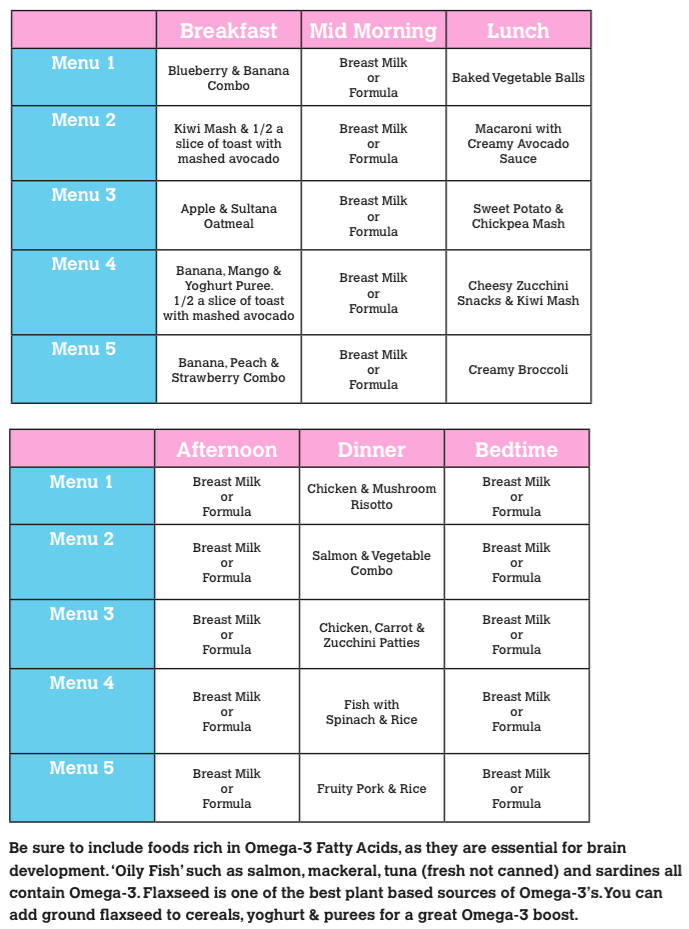 healthhub.sg/live-healthy/617/wholegrain%20for%20children" title="Introducing Wholegrains to Your Child">Introducing Wholegrains to Your Child</a></strong></p></div><div><h3>Friendly Reminders for Mum and Dad</h3><h4>6 to 9 months: smooth, soft and fine texture</h4><p>When you first start your baby on solids, the food you feed him should be smooth, soft, and fine in texture. As the little one grows older and gets better at chewing, you can gradually feed him food that is thicker and coarser—for example, a thicker puree.</p><p>
healthhub.sg/live-healthy/617/wholegrain%20for%20children" title="Introducing Wholegrains to Your Child">Introducing Wholegrains to Your Child</a></strong></p></div><div><h3>Friendly Reminders for Mum and Dad</h3><h4>6 to 9 months: smooth, soft and fine texture</h4><p>When you first start your baby on solids, the food you feed him should be smooth, soft, and fine in texture. As the little one grows older and gets better at chewing, you can gradually feed him food that is thicker and coarser—for example, a thicker puree.</p><p>
<strong>Related:
<a href="https://www.healthhub.sg/live-healthy/9/guide_your_growing_baby" title="Your Growing Baby">Your Growing Baby</a></strong></p><h4>Food prep pointers</h4><p>If you’re making your own baby food, make sure to prepare it without oil. Some great cooking methods are steaming, boiling, baking, or microwaving. No stir-frying or grilling yet for the little one! Remember to skip the sugar, salt and any other seasonings (e.g. soy sauce) when preparing the meals.</p><p>
No stir-frying or grilling yet for the little one! Remember to skip the sugar, salt and any other seasonings (e.g. soy sauce) when preparing the meals.</p><p>
<strong>Related:
<a href="https://www.healthhub.sg/live-healthy/1804/from-goreng-to-grill-healthier-cooking-methods" title="From Goreng to Grill: Healthier Cooking Methods">From Goreng to Grill: Healthier Cooking Methods</a></strong></p><h4>
</h4><h4>
<img src="/sites/assets/Assets/Categories/Pregnancy%20and%20Infant%20Health/35_Opmz_913370376.jpg" alt="Steaming is a healthy way to prepare food for your 7-month-old baby" />
</h4><h4>
</h4><h4>Be patient</h4><p>If your baby isn’t interested in a certain food, do not force it. There’s also no need to force your child to finish everything on his plate! Stop feeding him if he rejects the food, and try again during the next meal. Right now, your baby knows best about how much he wants to eat.</p><p>
Right now, your baby knows best about how much he wants to eat.</p><p>
<strong>Related:
<a href="https://www.healthhub.sg/live-healthy/1227/baby-getting-ready-for-solids" title="Getting Ready for Solids">Getting Ready for Solids</a></strong></p><h4>What makes 1 serving?</h4><div><table cellspacing="0" border="1"><tbody><tr><td><p>
<strong>Brown rice and wholemeal bread</strong></p></td><td><p>½ bowl of brown rice/rice (100g)
½ bowl of noodles, spaghetti or beehoon (100g)
1 large potato (180g)
</p></td></tr><tr><td><p>
<strong>Fruit</strong></p></td><td><p>1 small apple, orange, pear or mango (130g)
1 wedge pineapple, papaya or watermelon (130g)
1 medium banana</p></td></tr><tr><td><p>
<strong>Vegetable</strong></p></td><td><p>¾ mug or 1 small rice bowl of cooked vegetables (100g)
¼ plate of vegetables</p></td></tr><tr><td><p>
<strong>Meat and others</strong></p></td><td><p>1 palm-sized piece of fish, lean meat or skinless poultry (90g)
2 small blocks of soft beancurd (170g)
¾ cup or 1 small rice bowl of cooked pulses (e.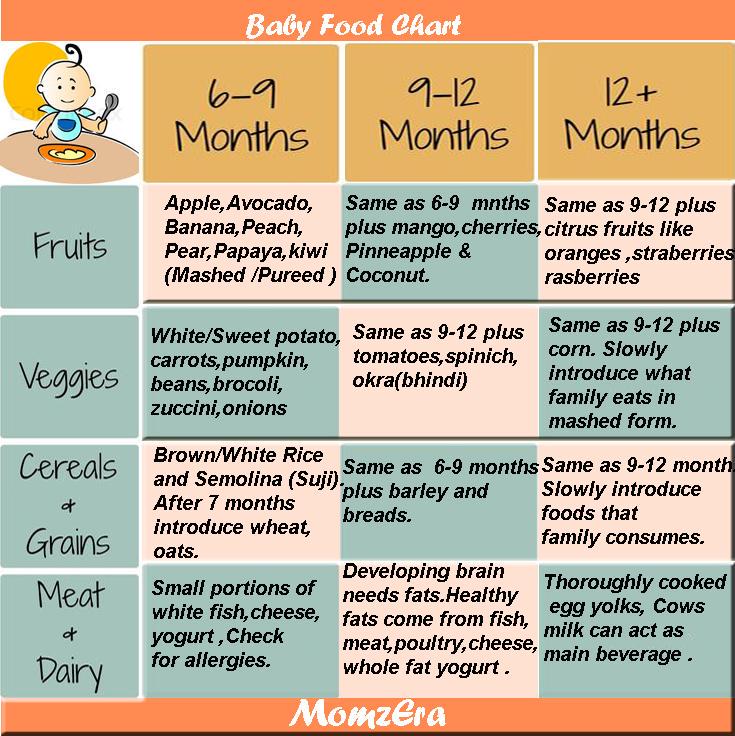 g. lentils) (120g)</p></td></tr></tbody></table></div></div><div>
g. lentils) (120g)</p></td></tr></tbody></table></div></div><div>
<p>
<strong>For more information on early nutrition and weaning recipes for your little one, visit
<a href="https://www.healthhub.sg/programmes/122/early-nutrition-for-babies" title="Early Childhood Nutrition">Early Childhood Nutrition.</a></strong></p><p>
<a href="https://www.healthhub.sg/programmes/183/parent-hub/baby-toddler">Visit Parent Hub, for more useful tips and guides to give your baby a healthy start.</a></p><p>
<em>Download the HealthHub app on
<a href="https://play.google.com/store/apps/details?id=sg.gov.hpb.healthhub&hl=en_SG" target="_blank" rel="nofollow">Google Play</a> or
<a href="https://itunes.apple.com/sg/app/healthhub-sg/id1034200875?mt=8" target="_blank" rel="nofollow">Apple Store</a> to access more health and wellness advice at your fingertips. </em> </p><hr /><p>
</em> </p><hr /><p>
<strong>Read these next:</strong></p><ul><li>
<a href="https://www.healthhub.sg/live-healthy/1927/Breastfeeding-as-a-Working-Mother" title="Breastfeeding as a Working Mother">Breastfeeding as a Working Mother</a>
</li><li>
<a href="https://www.healthhub.sg/live-healthy/156/babys_first_food_journey" title="Baby's First Food Journey">Baby's First Food Journey</a></li><li>
<a href="https://www.healthhub.sg/live-healthy/2028/nutrition-for-toddlers-12-24-months" title="Early Childhood Nutrition: Food Guide for Your One-Year- Old">Early Childhood Nutrition: Food Guide for Your One-Year- Old</a>
</li><li>
<a href="https://www.healthhub.sg/live-healthy/1959/Early-Nutrition-Baby-Switching-Cows-Milk" title="Early Nutrition: Switching to Cow’s Milk for Babies">Early Nutrition: Switching to Cow’s Milk for Babies</a> </li><li>
<a href="https://www. healthhub.sg/live-healthy/2020/getting-baby-started-on-solids" title="Getting Your Baby Started on Solids">Getting Your Baby Started on Solids</a> </li><li>
healthhub.sg/live-healthy/2020/getting-baby-started-on-solids" title="Getting Your Baby Started on Solids">Getting Your Baby Started on Solids</a> </li><li>
<a href="https://www.healthhub.sg/live-healthy/1579/things-new-dads-need-to-know" title="Things New Dads Need to Know">Things New Dads Need to Know</a>
</li></ul></div></div>
Thursday, October 25, 2018
Thursday, November 1, 2018
No
2021
Tuesday, November 15, 2022
<div>Health Promotion Board </div>
/sites/assets/Assets/Logos%20and%20Official/HPB%20CMYK%20Logo%20Padded. jpg
jpg
Health Promotion Board
https://www.hpb.gov.sg
7-month-baby Diet: An Authoritative Guide by Our Experts
Articles
7 Month Old Baby Food
Published: by Dora · This post may contain affiliate links ·
Sharing is caring!
A 7 month old baby can eat most things, but sometimes it is confusing how much, when, and what to feed them - see this helpful 7 month old baby food chart, meal plans, meal ideas, puree recipes and finger food ideas.
Jump to:- Food for 7 month baby chart / diet chart
- Foods for 7 month old baby
- 7 month old food menu / meal plan
- 7 Month Old Meal Plan
- Baby food recipes for 7 month old baby (breakfast, lunch and dinner ideas)
- BLW / Finger food recipes for 7 month old baby
- Wean with Confidence eBOOK
- Feeding tips for seven month old baby
- More seven month old Baby Recipes
If you’ve started your baby on purees, at 6 months these were most likely smooth purees.
So at 7 months we can move to more textured purees. If you’re ready that is. If you do choose to experiment with textures, this would only be a slight change from smooth purees.
So instead of preparing really smooth purees in a blender, you can just stop blending a little earlier (or you can mash the soft cooked food with a fork).
As with a 6 month old baby, you should introduce food one by one, to make sure no allergies are present (following the guidelines of the American Academy of Pediatrics, American Dietetic Association and World Health Organization)
Food for 7 month baby chart / diet chart
The sample menu below is based on FAO/WHO/UNU Energy Requirements for an average 7-month-old who weighs 19 lbs (8.6kg).
These meal plans were developed by Dora Babic-Cikos, Phd, our resident nutritionist.
If your baby is bigger or smaller than this that is ok. Every baby is different and this is just an average.
Every baby is different and this is just an average.
This is not a personalized plan, so please bear this disclaimer in mind.
The Food Chart Table for a 7 month old baby shows the recommendations in servings for all the food groups but at this age, it is not important that all food groups are included each day.
Babies are at this age starting to explore new textures and tastes so it is more guidance on how much of a food group to serve in a meal rather than including all food groups throughout the day.
You can check out the Wean With Confidence for a full 6-12 Month Meal Plan here (7 months of nutritionist-made meal plans and over 100 recipes where you choose whether you want baby-led weaning or puree).
Foods for 7 month old baby
Any food can be given to a seven month old baby other than honey. Honey is not allowed until the child is 1 years old due to botulism concerns.
Food can be given to babies as purees/mashed, or as baby-led weaning.
- breastmilk/formula is still the main source of nutrition
- fruits
- banana
- cooked apple
- pears,
- mango
- blueberries
- raspberries
- blackberries
- plums
- nectarines
- peaches
- pineapple
- melon
- vegetables
- broccoli
- cauliflower
- parsnips
- peas
- spinach
- zucchini
- eggplant
- carrots
- asparagus
- butternut squash
- sweet potato
- potato
- avocado
- carrots
- beetroot
- grains
- oats
- rice (once a week due to arsenic exposure)
- wholewheat products - pasta, bread
- millet
- quinoa
- barley
- bulgur wheat
- protein foods
- chicken
- turkey
- lamb
- beef
- pork
- eggs (cooked thoroughly)
- fish (no bones)
- chickpeas
- lentils
- beans
- tofu
- dairy - pasteurized, no added sugar or salt
- cheese
- full fat yogurt
- kefir
- whole pasteurized full fat cow's or goat's milk can be used for cooking but as a drink wait until baby is 1 year old
- fats
- nut butters
- seed butters
- olive oil
- avocado
Foods to avoid
- Cow’s milk – digestive system not yet adapted
- Low-fat milk and dairy products – cause excessive intake of protein and low intake of essential fats
- Honey – can cause botulism
- Salt – kidneys not sufficiently developed
- Fruit juices – high sugar content
- Unpasteurized products – can contain dangerous bacteria
- Smoked & cured meats / processed food – excessive salt intake
- High mercury fish (fresh tuna, halibut, grouper, shark) – excessive intake of mercury
- Chocolate, especially dark – caffeine content
The below is a sample 7 month old food menu based on the FAO/WHO/UNU Energy Requirements for an average 7-month-old who weighs 19 lbs / 8.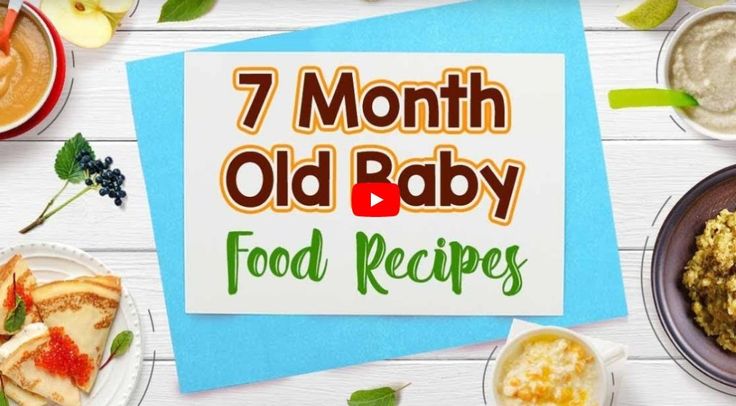 6 kg.
6 kg.
If your baby is bigger or smaller or eats/wants more food or less that is fine.
We propose 3 milk feedings and 2 solid meals, but you can split them however it works for you and your family.
Each recipe can be made as a puree, baby-led weaning option or mashed food (if you are transitioning away from purees).
7 Month Old Meal Plan
Breakfast
- 8 oz breastmilk or formula
Lunch – Sunny Sweet Quinoa (click here for recipe)
- 1 tablespoon quinoa (uncooked measure)
- 2 tablespoons water to cook the quinoa
- ½ medium-sized peach
- ½ teaspoon cinnamon
Snack
- 8 oz breastmilk or formula
Dinner – Cottage Cheese Blackberry Millet (click here for recipe)
- 2 tablespoons cottage cheese
- 2 tablespoons millet (uncooked measure)
- 4 tablespoons water to cook the millet
- 3 blackberries
- ½ teaspoon cinnamon
Before bedtime
- 8 oz breastmilk or formula
Note on water:
- Continue giving your baby a few sips of water with each meal (see how to drink from an open cup)
- If they seem to be drinking well, keep offering them up to around 2-3 oz (60-90ml) per meal.

- Breastmilk/formula and solid food also contain significant amounts of water so dehydration if highly unlikely even if they only take a few sips but they should be gradually learning to drink more and more
Meal plans and baby food charts for other ages are available in the baby food charts section such as Meal plan for 6 month old baby, 8 month old baby food chart, 9 month old baby food chart, 10 month old baby food and diet chart or the 10 month old meal plan, 11 month old meal plan and 1 year old baby food chart.
Baby food recipes for 7 month old baby (breakfast, lunch and dinner ideas)
Strawberry Oatmeal
Strawberry Oatmeal – a perfect healthy recipe for your baby. Loaded with healthy carbs and antioxidants your baby will enjoy.
Check out this recipe
Apple Banana Oatmeal
A great, high-calorie breakfast that's quick to make and a perfect start to the day for a 6-month-old and up!
Check out this recipe
Apple Cinnamon Overnight Oats
No-cook method for oats that you can prep the night before and have breakfast for your baby/toddler (and yourself) ready as soon as you get up. Delicious and easy Apple Overnight Oats will give your baby important nutrients to help them grow.
Delicious and easy Apple Overnight Oats will give your baby important nutrients to help them grow.
Check out this recipe
Banana Buckwheat Puree
An easy, tasty stage 1 baby puree. This Banana Buckwheat puree is full of calories, fiber and essential nutrients that you baby will like.
Check out this recipe
Zucchini Sweet Potato Puree for Baby
Although vegetable purees might not be your baby's favorite, the sweet taste and creamy texture in this Zucchini Sweet Potato Puree will have them wanting more!
Check out this recipe
Apple Sweet Potato Baby Puree
Easy, healthy homemade apple sweet potato baby puree recipe that your baby will love. A perfect stage 1 baby puree recipe that your baby will love.
Check out this recipe
Puree Carrots for Baby Recipe
This puree carrots for baby recipe is a great stage 1 baby food recipe that can be made in 3 ways and served either as carrot puree, carrot mash and baby-led weaning for your 6 month old baby or older. Only 5 min prep.
Only 5 min prep.
Check out this recipe
Chicken Butternut Squash Baby Food Recipe
Almost entirely hands-off, easy method to make the nutritious protein rich Chicken Butternut Squash Baby food recipe. Can be served to babies from 6 months old either as a stage 1 baby food puree combination, stage 2, stage 3 or as baby-led weaning.
Check out this recipe
Easy Red Lentil Soup Recipe for Baby
10 min prep, 30 min to cook this nutritious, tasty and easy Red Lentil baby soup recipe is perfect for a 6 month old baby and older. Can be given if you are doing baby-led weaning, for toddlers, kids and it is so delicious adults will love it.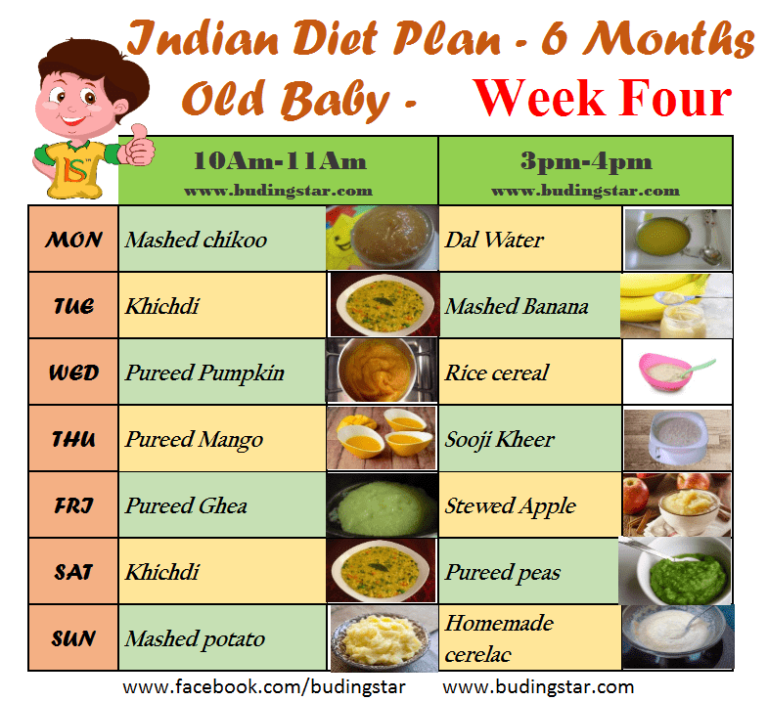 Make a big batch and freeze it for days you don't want to cook. It's naturally vegan, dairy-free, and gluten-free.
Make a big batch and freeze it for days you don't want to cook. It's naturally vegan, dairy-free, and gluten-free.
Check out this recipe
Chicken-Carrot Mash
Chicken Carrot Mash is a quick and nutritious recipe for a 6 month old baby that is simple and can be either BLW or pureed.
Check out this recipe
BLW / Finger food recipes for 7 month old baby
3-ingredient Oat Banana Pancake for Baby
Easy, healthy banana pancakes for baby are made with just 3 ingredients - oats, bananas and eggs. Made in 10 min, perfect for 6 month old baby-led weaning , toddlers and even adults love them. Great with peanut butter and fruit, as breakfast or on-the-go snack. Once you make them they will become a staple in your kitchen.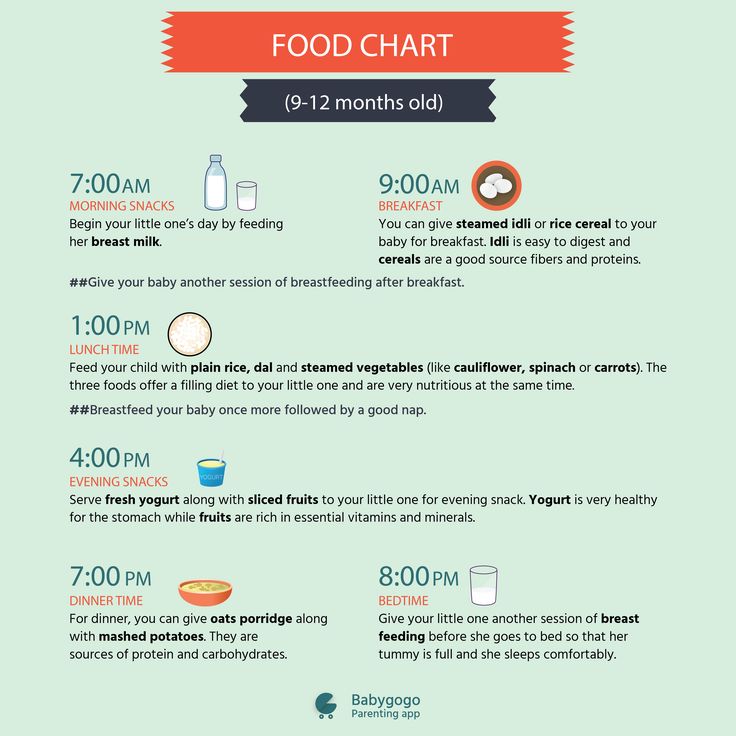 Can be made with no egg (vegan), and are gluten-free and naturally dairy-free.
Can be made with no egg (vegan), and are gluten-free and naturally dairy-free.
Check out this recipe
Banana Spinach Pancakes Baby Recipe
A great way to add nutritious spinach to a baby recipes. These healthy spinach pancakes are made with just 4 ingredients - banana, oats, egg and spinach and in 10 minutes. Perfect for 6 month old baby-led weaning, toddlers, kids and even adults love them.
Check out this recipe
Zucchini Cake
Add more vegetables to your child's diet with this simple yet delicious zucchini cake – a perfect healthy snack to take with you while you're out and about!
Check out this recipe
Mini Zucchini Pizza Bites
This easy, healthy Mini Zucchini Pizza Bites recipe is a perfect appetizer, snack, or even lunch and dinner for baby, toddlers, kids and the whole family. Made in 4 easy steps they will become a part of your family menu.
Made in 4 easy steps they will become a part of your family menu.
Check out this recipe
Best Red Lentil Vegan Bolognese
Rich and hearty, this delicious red lentil vegan bolognese tastes like the original, no joke. Made with healthy vegetables such as mushrooms, carrots, celery, and walnuts and finished with flavorsome bolognese herbs. The whole dish tastes almost exactly the same as an authentic bolognese yet it is healthy, vegan, and loved by babies, kids, and adults. Even my husband, who adores the original bolognese, now prefers this as it makes him feel full but light.
Check out this recipe
Broccoli Cheese Cakes
Broccoli Cheese Cakes - easy, quick and a perfect meal to take to the park or make a large batch and freeze for those days you don't wanna cook
Check out this recipe
Sweet Potato Pancakes
The BEST, super easy, and nutritious sweet potato pancakes – perfect for baby-led weaning, finger food and to take on-the-go.
Check out this recipe
Spinach Cornbread Muffins
15 min prep, 1 bowl, healthy and nutritious Spinach Cornbread Muffins that are great for babies and toddlers (and you will love them too)
Check out this recipe
Wean with Confidence eBOOK
For more recipes, meal plans, shopping lists, and just a general weight off your shoulders, check out the book Wean With Confidence, written by Dora Babic-Cikos, Phd.
Feeding tips for seven month old baby
- offer foods one by one to control for allergies
- print out this FREE Meal planner and the baby food chart and stick on your fridge
- start moving from purees to textured/mashed food (or continue with BLW)
- always be present when baby is eating
- avoid salt and sugar
- no honey before 1 year old
- no cow's milk or goat's milk unless cooking
- don't worry about how much they are eating - breastmilk/formula is still the main source of nutrition and they are exploring new foods
- offer purees/mashed foods on a preloaded spoon (have a few spoons on hand)
- have a great bib to minimize cleaning
- serve food in a suction bowl so baby can scoop food out themselves
- teach them to drink little sips from an open cup from the beginning
- notice when baby is full because they will start turning their head away, clamp lips, throw food on the floor, spit food out, push food away
More seven month old Baby Recipes
Diet for a child aged 7 months
When compiling a diet for a seven-month-old baby, distribute the products so that you get a certain prototype of the menu of an already grown-up child with breakfast and lunch.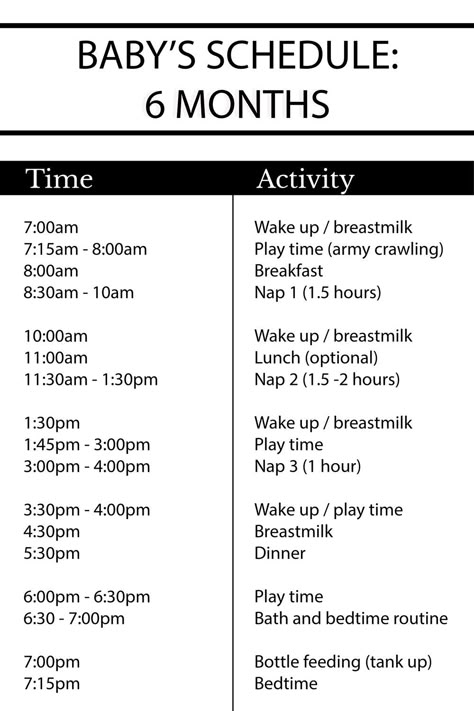
At this age, the yolk of a boiled chicken egg, a valuable source of fat, vitamin B12, A, phosphorus and selenium, is introduced into the child's diet. Chopped yolk can be added to porridge or vegetable puree.
At the age of 7 months, you can already give your baby a cracker (in the form of dried bread) and baby biscuits.
The volume of fruit puree and juice is increased to 70 g.
It is still better to give preference to commercially produced complementary foods, given their high degree of safety and variety. If the baby does not perceive a new product the first time, it can be mixed with an already familiar product.
Approximate diet for a child aged 7 months.
| I feeding 6 hours | Breast milk or VHI* | 200 ml |
| II feeding 10 hours | Dairy-free or milk porridge ** Butter Boiled egg yolk Supplementation with breast milk or VHI | 150 g |
| III feeding 14 hours | Vegetable puree Vegetable oil Meat puree Fruit juice | 170 g approx. 1 tsp. 30 g 70 ml |
| IV feeding 18 hours | Fruit puree Baby biscuits Breast milk supplement or VHI | 70 g |
| V feeding 22 hours | Breast milk or VHI | 200 ml |
* - infant formula
** - dairy-free porridge should be diluted with breast milk or infant formula that the child receives. Milk porridge is diluted with water.
Approximate diet of a 7-month-old child with cow's milk protein allergy:
| I feeding 6 hours | Breast milk or formula for infants with intolerance to cow's milk proteins | 200 ml |
| II feeding 10 hours | Dairy-free porridge* Vegetable oil Fruit puree (apple, pear) | 130 g approx. 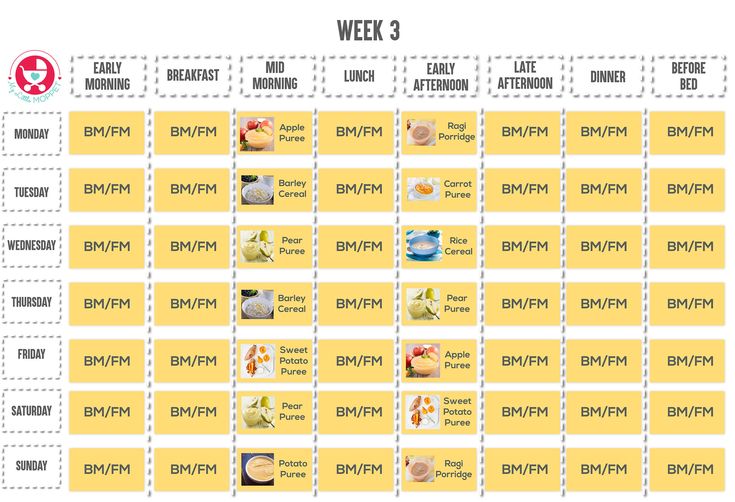 1 tsp. 1 tsp. 70 g |
| III feeding 14 hours | Vegetable puree Vegetable oil Meat puree (rabbit, turkey) | 170 g approx. 1 tsp. 30 g |
| IV feeding 18 hours | Vegetables or dairy-free porridge** Vegetable oil Meat puree | 180 g approx. 1 tsp. 20 g |
| V feeding 22 hours | Breast milk or medicated formula for infants with cow's milk protein intolerance | 200 ml |
* - dairy-free porridge should be diluted with breast milk or formula for children with intolerance to cow's milk proteins.
** - you can either alternate porridge or vegetables, or offer a mixed dish - porridge with vegetables.
Baby menu at 7 months: what is possible and what is not yet
- Anastasia Ivanovna, what are the nutritional features of children at 7 months?
- The menu for a baby at seven months is different from the menu for a newborn and a baby at one year old. This difference exists due to the fact that a number of body systems, including the gastrointestinal tract and oral cavity, have not yet been formed in a newborn, he is only learning to suck. From four to six months, the diet begins to include complementary foods - food that is different from breast milk or infant formula. In the year of the child, in ideal conditions, they are transferred to a common table.
This difference exists due to the fact that a number of body systems, including the gastrointestinal tract and oral cavity, have not yet been formed in a newborn, he is only learning to suck. From four to six months, the diet begins to include complementary foods - food that is different from breast milk or infant formula. In the year of the child, in ideal conditions, they are transferred to a common table.
Some pediatricians recommend introducing complementary foods from five to six months, sometimes even from four. But the enzymatic system of the baby's body has not yet been formed, so pedagogical complementary foods are possible at four or five months, and pediatric complementary foods by six months.
— How to combine breastfeeding or bottle feeding with complementary foods?
— Pediatricians and nutritionists recommend separating these meals and giving the main dairy food and complementary foods in separate meals so that the child understands what he is eating.
If complementary foods started at 4-5 months
— What rules of baby food should parents know?
— The functions of the gastrointestinal tract are formed in such a way that the body needs to adapt to the incoming products. With proper complementary foods, it is important to monitor the child's condition in the food diary and, if necessary, consult a doctor.
Basic feeding recommendations for seven-month-old babies
- One new product is given in small doses at the beginning of the day every four days to monitor for allergies, constipation, peeling and other reactions.
- One new food can be given per feeding.
- Water is best offered between feedings and not given with complementary foods.
- Do not force-feed: if the child refuses a certain dish, it can be offered at another time and in a different form.
- The child is not given unfamiliar food when he is not in a very good mood, teething, or has just been vaccinated.
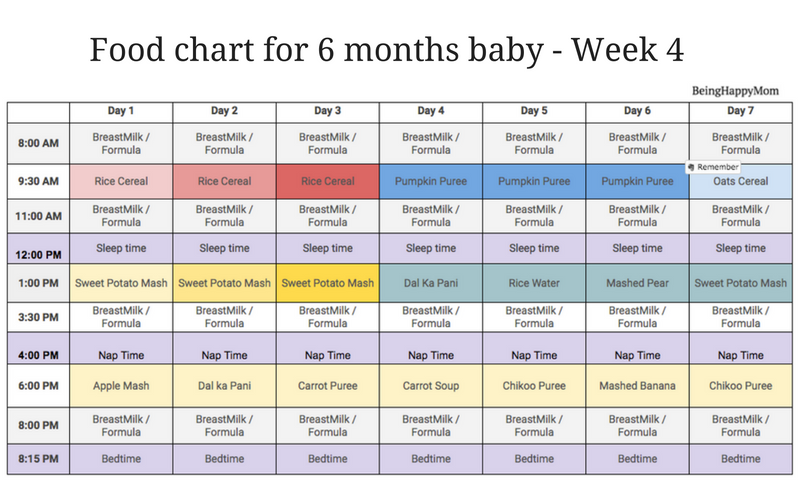
- How to identify food allergies and find the allergen?
- Observant mothers will see or hear the problem. The baby will have something on the body, constipation or indigestion will begin. A restless child will cry. To track the allergen, it is advisable to keep a food diary and keep your finger on the pulse. If there is a connection with the pediatrician, ask questions and, taking into account the vaccination calendar, the physiology of the development of your child, offer him certain products so as not to once again provoke an immune response.
What foods can be given at 7 months
Read also
- Why it is necessary to introduce meat complementary foods into the baby's diet and with what products it can be combined.
- What purees and cereals can be given at 7 months?
- If this is the first complementary food for a baby, then monocomponent purees, dairy-free and milk porridges with one cereal in the composition are good: they are easier to digest and it is easier to track the reaction of the body using them.
— In what order can complementary foods be given?
— If your baby is overweight by the age of seven months, it is better to feed him vegetable puree. If everything is in order with weight, then preference can be given to cereals. All new products are introduced gradually: they begin to feed in the amount of 5-10 g, gradually increasing the volume to 50 g. By seven months, a portion of porridge at one time can reach up to 200 g. The third option for complementary foods, if parents want, can be fruit. It is in this sequence, because fruits are sweet, and the child does not always eat unleavened vegetables or cereals after them.
Each product will also have its own processing specifics:
- vegetables and fruits are given in the form of puree;
- purchased cereals are prepared according to the instructions;
- homemade porridges are boiled in water, then milk or mixture is added if desired;
- cottage cheese is properly stored in the refrigerator, tracking the expiration date;
- dairy, vegetable broths are brought to a single consistency (puree) so that the child develops the correct perception of the product.

— How many times to feed a baby at 7 months and how much food to give?
- You need to focus on five feedings per day. If your baby cannot tolerate the interval between meals, it is worth supplementing with breast or formula after the introduction of complementary foods.
How to calculate complementary foods
A baby at seven months should weigh about eight kilograms. 1/8 of the child's weight is the daily amount of food, that is, approximately a kilogram of food, taking into account all feedings, or 200 grams per meal.
Sample menu for a 7-month-old baby (Russian Federation)
— At what age can semi-solid and solid foods be introduced into a child's diet?
- By 6 months, most babies are ready for a new food: the baby realizes that something is hard in his mouth. By the age of seven months, the skill of palmar grip is formed: the child is able to hold solid food in his hand, and he can be given biscuits and crackers to grind. Allergists and pediatricians consider 6-10 months as the optimal period to begin the introduction of semi-solid and solid foods. But if the swallowing apparatus is not formed, there may be problems with chewing and swallowing disorders up to the gag reflex.
By the age of seven months, the skill of palmar grip is formed: the child is able to hold solid food in his hand, and he can be given biscuits and crackers to grind. Allergists and pediatricians consider 6-10 months as the optimal period to begin the introduction of semi-solid and solid foods. But if the swallowing apparatus is not formed, there may be problems with chewing and swallowing disorders up to the gag reflex.
— What should parents do if their child refuses to eat? How to create food interest?
— It is necessary to understand the reasons for the baby's refusal to eat, among which may be: The pediatrician will track changes in health by analysis and, if necessary, adjust the diet.
At seven months, significant changes occur in the work of the gastrointestinal tract, the child actively shows interest in "adult" products, in new tastes. It will be easier for the baby to readjust if you choose products that will match his physiology and fully cover his needs for growth and communication.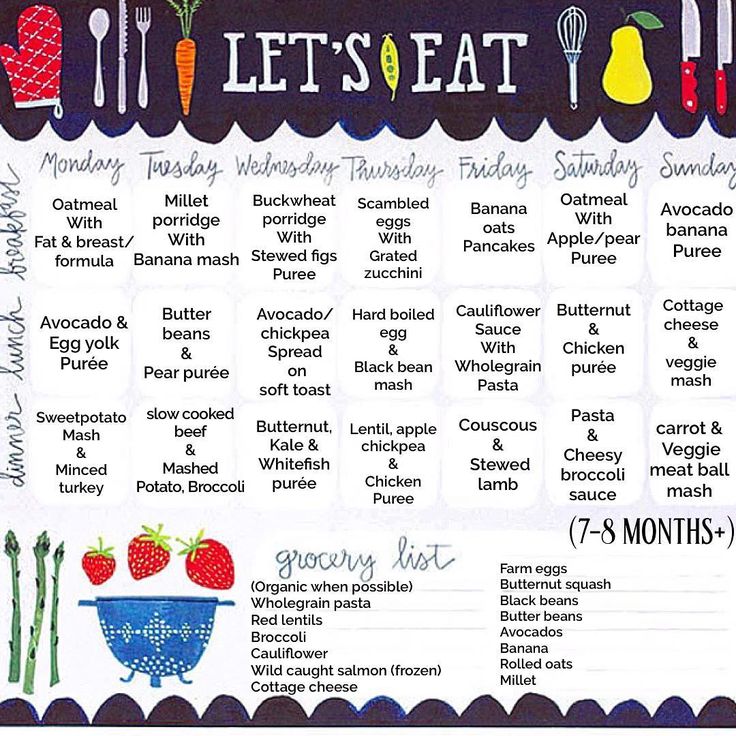

 g. lentils) (120g)
g. lentils) (120g)
